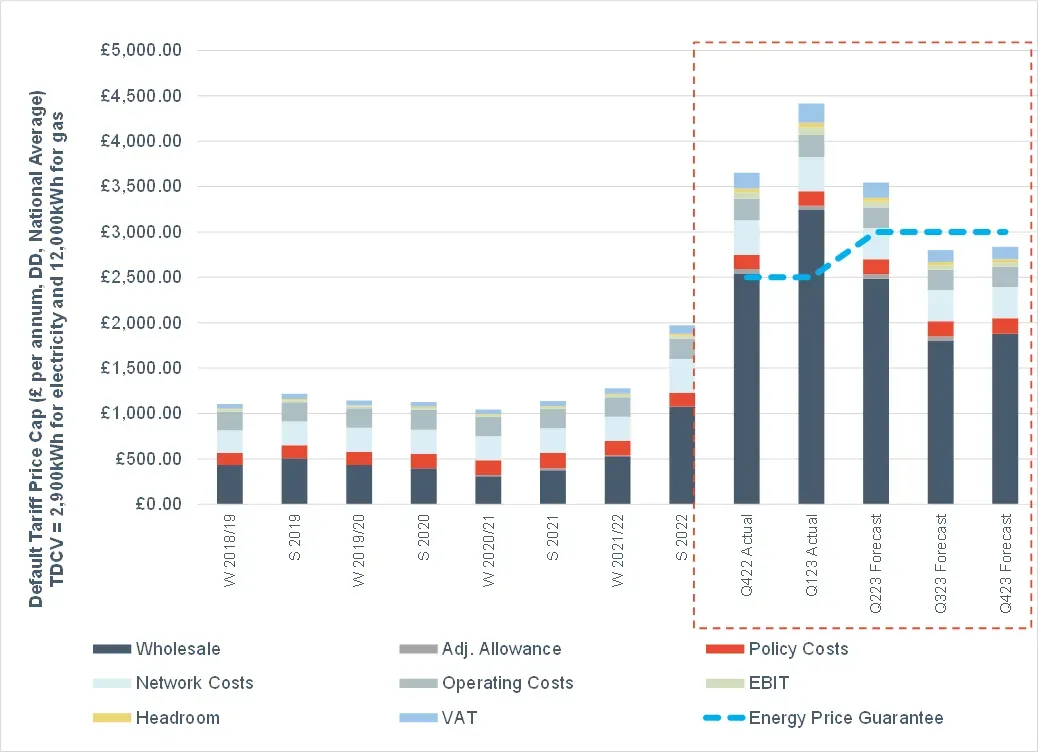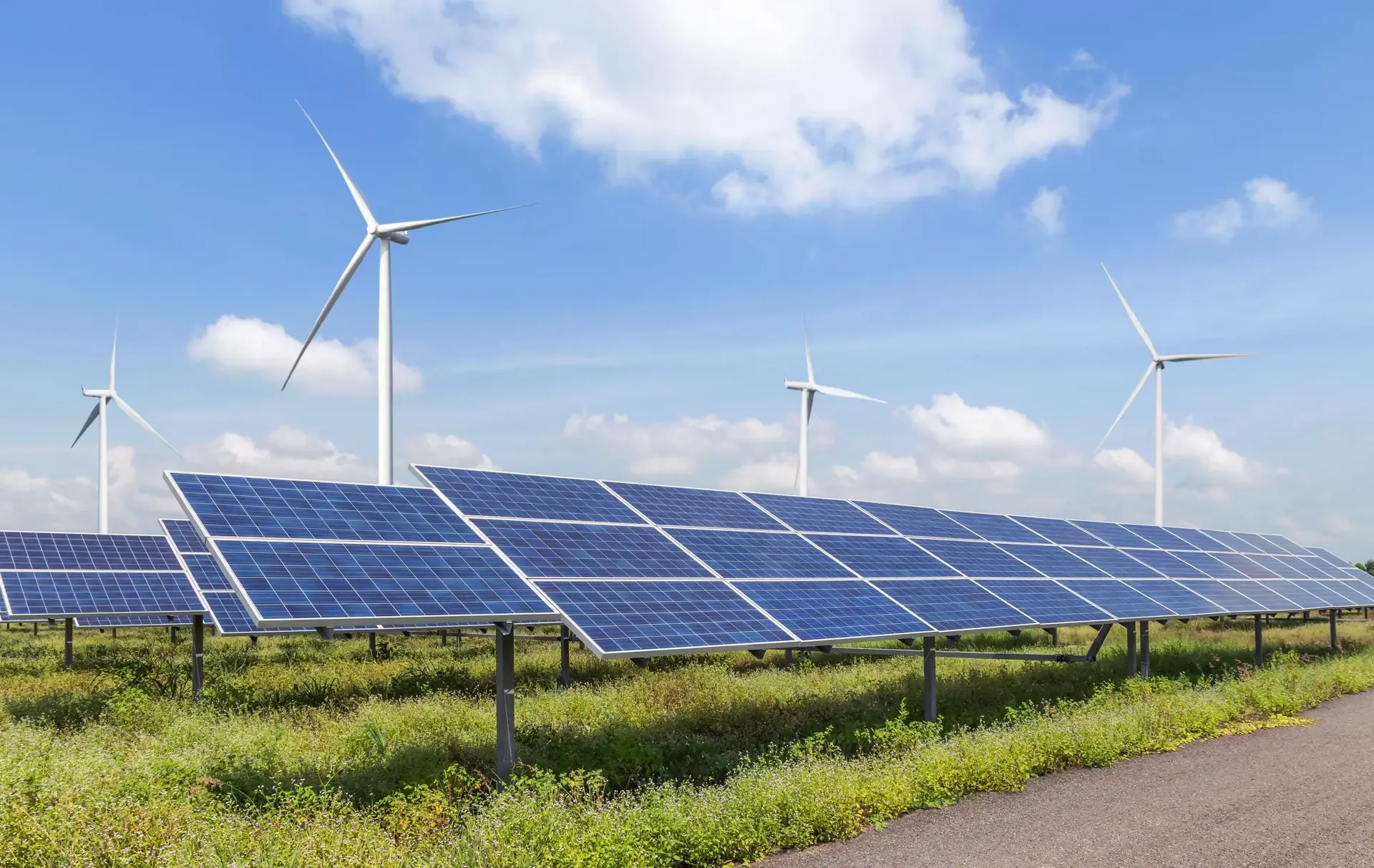"It is clear that blanket measures of bill support are not providing adequate protection for the most vulnerable and more targeted measures including social tariffs may be something for the government to consider."
Dr Craig Lowrey Principal Consultant
The predictions for the Default Tariff Cap in this piece are out of date please click HERE to find our most up to date forecasts.
The latest forecasts for the Default Tariff Cap (price cap) released by Cornwall Insight, have shown energy bills for a typical household are predicted to be below the government’s Energy Price Guarantee (EPG) from July (Q3 2023) this year. Despite the fall in these forecasts, bills are set to remain significantly above pre-pandemic levels – settling at around £2,800 for the second half of 2023, £300 above the current capped EPG rate of £2,500.
Falling wholesale energy prices are the main contributor to the predicted drop in the cap forecast. But these falls will not have their main effects until Q3 2022 as energy suppliers typically buy their energy ahead of time (hedging) to comply with the cap. This means falling day-to-day wholesale prices (spot prices) have a limited impact in the short-term.
The EPG was introduced to partially shield consumers from high energy prices, with the government capping consumer energy bills, and compensating suppliers the difference between the cap and the EPG. With the EPG currently set to increase to £3,000 per year from April 2023, if the price cap does indeed ultimately end up below the prevailing EPG level, then the support scheme will effectively no longer be a cost to the government as we move into the second half of 2023.
Even if current levels of wholesale prices are maintained, then the pressure may well still be there for the government to assist consumers in homes and businesses, as bills will still remain extraordinarily high. For example, our current forecast of the Q3 2023 domestic cap of just over £2,800 per annum is over twice the corresponding 2021 cap level.
Despite the drop in the price cap, the overall cost to the government of the EPG for the period to 31 March 2024 is still a predicted £37bn, money which will need to be recovered through the taxpayer.
Figure 1: Cornwall Insight’s Default tariff cap forecasts
| QUARTERLY | Q2 2023 (Apr – Jun) Forecast | Q3 2023 (Jul-Sept) Forecast | Q4 2023 (Oct – Dec) Forecast |
|---|---|---|---|
| Electricity | £1,725.51 | £1,243.91 | £1,308.02 |
| Gas | £1,819.80 | £1,556.26 | £1,527.14 |
| TOTAL | £3,545.31 | £2,800.16 | £2,835.16 |
Source: Cornwall Insight analysis
Figure 2: Default Tariff Price cap levels chart since 2018 and Cornwall Insight’s predictions for the next three cap rises

Source: Cornwall Insight analysis
Figure 3: Default Tariff Price cap forecasts, Per Unit Cost and Standing Charge including VAT (dual fuel, direct debit customer, national average figures)
| Electricity | Q223 Forecast | Q323 Forecast | Q423 Forecast |
|---|---|---|---|
| Standing Charge (£/day) | 0.33 | 0.33 | 0.33 |
| Per Unit Costs (p/kWh) | 55.29 | 38.68 | 40.91 |
| Gas | Q223 Forecast | Q323 Forecast | Q423 Forecast |
|---|---|---|---|
| Standing Charge (£/day) | 0.30 | 0.30 | 0.30 |
| Per Unit Costs (p/kWh) | 14.25 | 12.06 | 11.82 |
Source: Cornwall Insight analysis
Dr Craig Lowrey, Principal Consultant at Cornwall Insight:
While it is positive to see a drop in the price cap forecast, household bills are set to remain high. With the Energy Price Guarantee rising in April, the second half of the year will still see a typical household facing bills that are well above historic levels and facing costs that many can ill afford.
The cap’s fall below the threshold of the EPG will, if wholesale prices continue at this level, effectively see the scheme no longer costing the government. We must remain cautious as the government has essentially been underwriting a volatile wholesale energy market – one which is likely to remain unstable throughout the year. Even if energy prices continue at current levels – which is a big if – the costs to the government over the full period of the EPG are still contributing to government borrowing and will ultimately fall at the feet of consumers in the form of higher taxes.
The government have indicated a desire to see reform in the energy market, including a review of domestic energy prices. It is clear that blanket measures of bill support are not providing adequate protection for the most vulnerable and more targeted measures including social tariffs may be something for the government to consider. While the details of future support are best left up to the judgement of politicians, the forecasts demonstrate we must look beyond the current policy if we are to see a fairer, more cost-efficient and enduring way of reducing household energy bills for those who need it the most.”
– Ends
Notes to Editors
For more information, please contact: Verity Sinclair at v.sinclair@cornwall-insight.com
To link to our website, please use: https://www.cornwall-insight.com/
About the Cornwall Insight Group
Cornwall Insight is the pre-eminent provider of research, analysis, consulting and training to businesses and stakeholders engaged in the Australian, Great British, and Irish energy markets. To support our customers, we leverage a powerful combination of analytical capability, a detailed appreciation of regulation codes and policy frameworks, and a practical understanding of how markets function.

